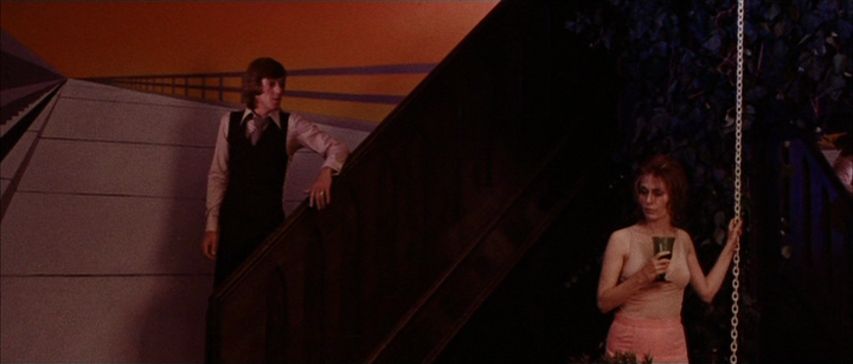
Willard Huyck and Gloria Katz’s Messiah of Evil (1973) begins with a fairly simple premise. Arletty (Marianna Hill) travels to the remote seaside town of Point Dume in search of her father (Royal Dano), a prominent artist, who has abruptly cut off all communications with the outside world. Point Dume is that familiar place that appears to be trapped fifty years in the past yet hasn’t prospered for years. It’s a quiet town seized by a uniquely American sort of weariness.
Katz and Huyck fill the nighttime exteriors of Point Dume with vibrant violet fills. The home of Arletty’s father is a series of wall murals, one a top the other in close succession, that capture in two-tone various scenes from Point Dume as if his house were the town in microcosm. Inside these dreamy spaces Arletty begins a dialogue with her missing father in the form of a call and response rendered in voice over. First her father speaks as she reads his diary and the accounts therein of a slow descent into madness. Arletty then responds, an interior dialogue, reflecting on her own encounters which only lend her father’s words more agency.
Wandering this ghost town Arletty meets Thom (Michael Greer) and his two travel companions. They move in with her. Their interactions, methodical and erotic, are rendered like some distant dream. Quickly this is all interrupted by the townsfolk who have become a mass of somnambulistic cannibals.
Messiah of Evil, as one might have guessed, is less concerned with plot and far more concerned with mood and atmosphere. The slow, tension filled pacing has, from the very beginning of the film, its own hypnotic rhythm that pulls the viewer in. There are so many outstanding set pieces and so much stellar production design that, even when little is happening in terms of plot, one simply cannot look away.
There’s some compelling intertextuality in Messiah of Evil. The filmmakers incorporate images and narrative elements from Invasion Of The Body Snatchers (1956), Carnival Of Souls (1962), and The Birds (1963) to great effect. But it is the influence of H.P. Lovecraft that permeates every frame of the film. Messiah of Evil is deeply rooted in the correlation between the fear of the unknown and the folklore born out of America in the nineteenth century.
Messiah of Evil is one of the quintessential American horror films of the seventies. This recently rediscovered classic has had a clear influence on such diverse filmmakers as Lucio Fulci and Anna Biller. The gorgeous restoration and home video release from Code Red is not to be missed.
